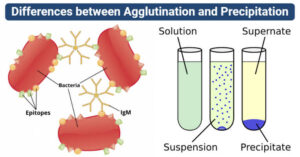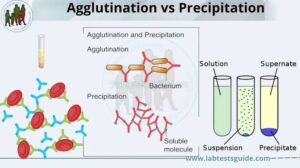Back to: MICROBIOLOGY 100 LEVEL
Welcome to class!
You’re truly doing a great job keeping up with these lessons—your understanding of microbiology is getting deeper and more impressive each day! Today, we’re going to look at three important ways antibodies help defend your body: agglutination, precipitation, and neutralisation. These are powerful defence strategies used by your immune system to trap, disable, and clear out harmful invaders. Let’s learn how they work using simple, relatable examples you can connect with.
Agglutination, Precipitation, Neutralisation
These three actions are all examples of antigen-antibody reactions. When your body detects something harmful (like a virus or bacteria), it produces antibodies. These antibodies don’t just float around—they get to work by binding to antigens in very specific ways.

Agglutination
Agglutination simply means clumping. It happens when antibodies bind to antigens that are on the surface of particles like bacteria or red blood cells and pull them together into clumps.
Think of it like this: if you have a bunch of enemies (bacteria) running in all directions, it’s hard to catch them. But if you tie them together with a rope (antibodies), they’re stuck in one place and easier to eliminate.
This clumping makes it easier for phagocytes (like macrophages) to come and destroy the invaders.
Example: In blood typing tests, antibodies cause agglutination to show which blood type is present. If you receive the wrong blood type during a transfusion, your body’s antibodies will agglutinate the foreign red blood cells, which can be dangerous.
Precipitation
Precipitation occurs when antibodies bind to soluble antigens (antigens that are dissolved in fluids) and form an insoluble complex that settles out of the solution.
Imagine you add salt to water and stir. If you keep adding, at some point the salt will no longer dissolve and will settle to the bottom—that’s precipitation.
In the immune system, this makes harmful substances easier for the body to remove, as the complex can now be phagocytosed.
Example: Precipitation can help remove toxins or small proteins from circulation by forming larger clumps that immune cells can handle more easily.
Neutralisation
Neutralisation is when an antibody blocks an antigen from working by covering it or stopping it from attaching to host cells.
Think of a virus as a key trying to enter your body’s cells through a lock. Neutralising antibodies act like glue in the keyhole, stopping the key from working.
It’s one of the most effective ways antibodies prevent infections, especially from viruses and toxins.

Example: Vaccines often work by encouraging the body to produce neutralising antibodies that block viruses (like measles or COVID-19) from entering your cells.
Summary
- Agglutination: Antibodies cause clumping of cells like bacteria or red blood cells, making them easier to remove.
- Precipitation: Antibodies bind to soluble antigens, forming solid complexes that settle out and can be cleared.
- Neutralisation: Antibodies block antigens (like viruses or toxins) from attaching to or entering body cells.
- All three are antigen-antibody reactions that help protect the body in different ways.
- These processes are used in diagnostics, vaccines, and immune defence.
Evaluation
- What happens during agglutination, and why is it helpful?
- Explain the difference between precipitation and agglutination.
- How does neutralisation protect the body from viruses?
The more you understand how your immune system works, the better equipped you are to make smart health choices and even excel in your medical or science career. Keep up the energy and excitement—Afrilearn is right here with you, helping you achieve your best. See you in the next class!
